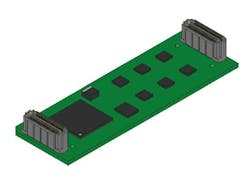VITA 93 QMC new open-systems standard for high-performance I/O on the horizon for small-form-factor modules
SAN ANTONIO, Texas – The embedded computing industry is on the verge of a new open-systems standard for small-form-factor high-performance I/O for military, industrial, and commercial aviation applications.
The VITA 93 QMC standard, soon to be released, will be for small-form-factor embedded computing architectures such as VNX and VITA 90 VNX+, which are credit card-sized computer boards, as well as for the emerging VITA 100 standard, expected sometime next year, which will involve 3U, 6U, and perhaps other form factors, and is expected to replace and augment OpenVPX embedded computing.
VITA 93 QMC
VITA 93 QMC is scalable, designed from the ground-up to be rugged enough for military, aviation, industrial, and rail applications. "It's a small-form-factor I/O mezzanine card, with the same concept as XMC, but in a smaller package," says Mark Littlefield, director of systems products at Elma Electronic in Fremont, Calif.
Littlefield made his comments Monday at the Embedded Tech Trends conference in San Antonio, Texas. QMC will have conduction- and convection-cooled versions, yet will be able to mix-and-match conduction and convection cooling in the same enclosure.
Related: The official Sensor Open Systems Architecture (SOSA) standard is out; so now what?
The inspiration for QMC came out of the VITA 90 VNX+ small-form-factor embedded computing module, Littlefield explains. "It has a lot of the same capabilities as OpenVPX modules. We needed to find a suitable small-form-factor mezzanine for use with VNX+." That means something small enough to fit inside the 19-millimeter VNX module.
One of the goals QMC is to support other embedded computing form factors, such as VME, CompactPCI, CompactPCI Express, and PCI Express edge finger modules, Littlefield says. "It's all about expansion -- adding I/O ports to the modules for functionality and storage."
Industry innovation
The high-performance I/O standard also seeks to stimulate technology innovation in the embedded computing business. "You can inter-mate conduction- and air-cooled modules and carriers," Littlefield says. "This is good for the lab, factory, or field deployment. People will be very innovative about cooling."
Among the expected applications for QMC are autonomous vehicles, edge computing, and artificial intelligence, Littlefield says. Some of the first designs for QMC will be as replacements for MIL-STD-1553 and CAN bus data interconnects.
Littlefield adds that QMC also could be a replacement for commercial aviation databuses such as ARINC-429. "I see no reason that ARINC 429 couldn't be part of this evolution," Littlefield says, adding that he sees no significant issues of certifying QMC for military and commercial applications.
About the Author
John Keller
Editor-in-Chief
John Keller is the Editor-in-Chief, Military & Aerospace Electronics Magazine--provides extensive coverage and analysis of enabling electronics and optoelectronic technologies in military, space and commercial aviation applications. John has been a member of the Military & Aerospace Electronics staff since 1989 and chief editor since 1995.
